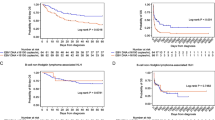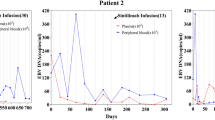Abstract
Epstein–Barr virus (EBV)-associated hemophagocytic lymphohistiocytosis (HLH) is highly prevalent in Japan. To date, no standard treatment for EBV–HLH has been established owing to the diversity in treatment response and the difficulty in assessing prognostic factors. The present prospective study recruited 27 children with EBV–HLH who were also part of the HLH-2004 study. EBV load in the peripheral blood was monitored at diagnosis and 2, 4, and 8 weeks after treatment initiation. Additionally, T-cell receptor (TCR) clonality and other laboratory data were evaluated. TCR clonality was positive in 14 patients at diagnosis. Seven of 27 patients experienced recurrences after treatment. No correlation was noted among any clinical data at diagnosis of patients with and without recurrence. However, the recurrence rate was significantly higher in patients aged < 2 years and/or those with a high plasma EBV load of > 103 copies/mL 2 weeks after treatment than that in patients without these factors. These findings suggest that a younger age or a high EBV load in plasma at the early phase of treatment is a factor predicting a recurrence and helps guide the intensity of subsequent treatment phases for children with EBV–HLH.
Similar content being viewed by others
Change history
11 April 2019
The correct name of the first author should be ‘‘Ryu Yanagisawa’’, and not ‘‘Ryu Yanagaisawa’’ as given in the original publication of the article.
References
Imashuku S. Clinical features and treatment strategies of Epstein–Barr virus-associated hemophagocytic lymphohistiocytosis. Crit Rev Oncol Hematol. 2002;44:259–72.
Ishii E. Hemophagocytic lymphohistiocytosis in children: pathogenesis and treatment. Front Pediatr. 2016;4:47.
Ishii E, Ohga S, Imashuku S, Yasukawa M, Tsuda H, Miura I, et al. Nationwide survey of hemophagocytic lymphohistiocytosis in Japan. Int J Hematol. 2007;86:58–65.
Kasahara Y, Yachie A. Cell type specific infection of Epstein-Barr virus (EBV) in EBV-associated hemophagocytic lymphohistiocytosis and chronic active EBV infection. Crit Rev Oncol Hematol. 2002;44:283–94.
Morimoto A, Nakazawa Y, Ishii E. Hemophagocytic lymphohistiocytosis: pathogenesis, diagnosis, and management. Pediatr Int. 2016;58:817–25.
Imashuku S, Kuriyama K, Teramura T, Ishii E, Kinugawa N, Kato M, et al. Requirement for etoposide in the treatment of Epstein-Barr virus-associated hemophagocytic lymphohistiocytosis. J Clin Oncol. 2001;19:2665–73.
Bergsten E, Horne A, Aricó M, Astigarraga I, Egeler RM, Filipovich AH, et al. Confirmed efficacy of etoposide and dexamethasone in HLH treatment: long-term results of the cooperative HLH-2004 study. Blood. 2017;130:2728–38.
Henter JI, Samuelsson-Horne A, Arico M, Egeler RM, Elinder G, Filipovich AH, et al. Treatment of hemophagocytic lymphohistiocytosis with HLH-94 immunochemotherapy and bone marrow transplantation. Blood. 2002;100:2367–73.
Trottestam H, Horne A, Arico M, Egeler RM, Filipovich AH, Gadner H, et al. Chemoimmunotherapy for hemophagocytic lymphohistiocytosis: long-term results of the HLH-94 treatment protocol. Blood. 2011;118:4577–84.
Ohga S, Kudo K, Ishii E, Honjo S, Morimoto A, Osugi Y, et al. Hematopoietic stem cell transplantation for familial hemophagocytic lymphohistiocytosis and Epstein–Barr virus-associated hemophagocytic lymphohistiocytosis in Japan. Pediatr Blood Cancer. 2010;54:299–306.
Shiraishi A, Ohga S, Doi T, Ishimura M, Takimoto T, Takada H, et al. Treatment choice of immunotherapy or further chemotherapy for Epstein-Barr virus-associated hemophagocytic lymphohistiocytosis. Pediatr Blood Cancer. 2012;59:265–70.
Kogawa K, Sato H, Asano T, Ohga S, Kudo K, Morimoto A, et al. Prognostic factors of Epstein–Barr virus-associated hemophagocytic lymphohistiocytosis in children: report of the Japan Histiocytosis Study Group. Pediatr Blood Cancer. 2014;61:1257–62.
Imashuku S, Teramura T, Kuriyama K, Kitazawa J, Ito E, Morimoto A, et al. Risk of etoposide-related acute myeloid leukemia in the treatment of Epstein–Barr virus-associated hemophagocytic lymphohistiocytosis. Int J Hematol. 2002;75:174–7.
Yanagisawa R, Nakazawa Y, Matsuda K, Yasumi T, Kanegane H, Ohga S, et al. Outcome in children with hemophagocytic lymphohistiocytosis treated using HLH-2004 protocol in Japan. Int J Hematol. 2019;109:206–13.
Henter JI, Horne A, Aricó M, Egeler RM, Filipovich AH, Imashuku S, et al. HLH-2004: diagnostic and therapeutic guidelines for hemophagocytic lymphohistiocytosis. Pediatr Blood Cancer. 2007;48:124–31.
Matsuda K, Nakazawa Y, Yanagisawa R, Honda T, Ishii E, Koike K. Detection of T-cell receptor gene rearrangement in children with Epstein–Barr virus-associated hemophagocytic lymphohistiocytosis using the BIOMED-2 multiplex polymerase chain reaction combined with GeneScan analysis. Clin Chim Acta. 2011;412:1554–8.
Kanda Y. Investigation of the freely available easy-to-use software ‘EZR’ for medical statistics. Bone Marrow Transpl. 2013;48:452–8.
Kimura H, Hoshino Y, Hara S, Nishikawa K, Sako M, Hirayama M, et al. Viral load in Epstein–Barr virus-associated hemophagocytic syndrome. Microbiol Immunol. 2002;46:579–82.
Imashuku S, Hibi S, Tabata Y, Itoh E, Hashida T, Tsunamoto K, et al. Outcome of clonal hemophagocytic lymphohistiocytosis: analysis of 32 cases. Leuk Lymphoma. 2000;37:577–84.
Kanakry JA, Hegde AM, Durand CM, Massie AB, Greer AE, Ambinder RF, et al. The clinical significance of EBV DNA in the plasma and peripheral blood mononuclear cells of patients with or without EBV diseases. Blood. 2016;127:2007–17.
Teramura T, Tabata Y, Yagi T, Morimoto A, Hibi S, Imashuku S. Quantitative analysis of cell-free Epstein-Barr virus genome copy number in patients with EBV-associated hemophagocytic lymphohistiocytosis. Leuk Lymphoma. 2002;43:173–9.
Acknowledgements
This work was supported by a Grant-in-Aid for Clinical Cancer Research from the Ministry of Health, Labour and Welfare of Japan (H20-GanRinsho-Ippan-017), by the Practical Research for Innovative Cancer Control from the Japan Agency for Medical Research and Development (AMED_16ek0109055h0003 and AMED_18ck0106462h0001), and by the Japan Leukemia Research Fund. The authors would like to thank Yūka Miyajima for assistance with preparation of the manuscript as well as secretarial assistance. The authors also thank Enago (http://www.enago.jp) for the English language review.
Author information
Authors and Affiliations
Corresponding author
Ethics declarations
Conflict of interest
The authors declare that they have no conflict of interest.
Additional information
Publisher’s Note
Springer Nature remains neutral with regard to jurisdictional claims in published maps and institutional affiliations.
About this article
Cite this article
Yanagaisawa, R., Matsuda, K., Ohga, S. et al. Factors predicting the recurrence of Epstein–Barr virus-associated hemophagocytic lymphohistiocytosis in children after treatment using the HLH-2004 protocol. Int J Hematol 109, 612–617 (2019). https://doi.org/10.1007/s12185-019-02612-2
Received:
Revised:
Accepted:
Published:
Issue Date:
DOI: https://doi.org/10.1007/s12185-019-02612-2




